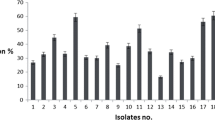Abstract
Yogurt exhibitsin vitro bactericidal activity against a variety of pathogenic microorganisms, includingClostridium difficile. In the present studies, we tested whether yogurt ingestion could prevent or ameliorate antibiotic associated colitis in the clindamycin-treated hamster model. Male golden Syrian hamsters were given 5 mg/kg clindamycin subcutaneously 24 hr before and 6 hr following inoculation with 0.5 ml of <10, 103, 105, or 106 CFU/ml ofC. difficile. Hamsters in the control group ingested chow and waterad libitum, whereas the experimental group ingested chow and a 1∶1 (v/v) mixture of yogurt and waterad libitum, beginning 24 hr before the first injection of clindamycin and continuing throughout the course of the study. Animals were monitored for colonization withC. difficile, pathological evidence of colitis, and death. Mortality was 100% in yogurt-treated animals, and all animals showed histological changes of severe colitis. Fecal and intestinal segment cultures were positive forC. difficile in all animals. Thus, in the hamster model, we found no evidence to support the possible efficacy of yogurt in the prevention ofC. difficile colitis.
Similar content being viewed by others
References
Bartlett JG, Chang TW, Taylor NS, Onderdonk AB: Colitis induced byClostridium difficile. Rev Infect Dis 1:370–378, 1979
Bartlett JG, Tedesco FJ, Shull S, Lowe B, Chang T: Symptomatic relapse after oral vancomycin therapy of antibiotic-associated pseudomembranous colitis. Gastroenterology 78:431–434, 1979
George RH, Symonds JM, Dimock F, Brown JD, Arabi Y, Shinagawa N, Keighley MRB, Alexander-Williams J, Burdon DW: Identification ofClostridium difficile as a cause of pseudomembranous colitis. Br Med J 1:695, 1978
Lyerly DM, Krivan HC, Wilkins TD:Clostridium difficile: Its disease and toxins. Clin Microbiol Rev 1(1):1–18, 1988
Corthier G, Dubos F, Ducluzeau R: Prevention ofClostridium difficile induced mortality in gnotobiotic mice bySaccharomyces boulardii. Can J Microbiol 32:894–896, 1986
Toothaker RD, Elmer GW: Prevention of clindamycin-induced mortality in hamsters bySaccharomyces boulardii. Antimicrob Agents Chemother 26:552–556, 1984
Kotz CM, Moody JA, Peterson LR, Savaino DA, Levitt MD: Thein vitro antibacterial effect of yogurt onEscherichia coli. Dig Dis Sci 35:630–637, 1990
Cuk Z, Anan-Prah M, Janc M, Zaji-Satler J: Yogurt: An unlikely source ofCampylobacter jejuni/coli. J Appl Bacteriol 63:201–205, 1987
Alm L: Survival rate ofSalmonella andShigella in fermented milk products with and without added human gastric juice; anin vitro study. Prog Fed Nutr Sci 7:19–28, 1983
Rubin HE, Vaughan F: Elucidation of the inhibitory factors of yogurt againstSalmonella typhimurium. J Dairy Sci 62:1873–1879, 1979
Attaie R, Whalen PJ, Shahani KM, Amer MA: Inhibition of growth ofStaphylococcus aureus during production of acidophilus yogurt. J Food Prot 50(3):224–228, 1987
Chang TW, Bartlett JG, Gorbach SL, Onderdonk AB: Clindamycin-induced enterocolitis in hamsters as a model of pseudomembranous colitis in patients. Infect Immun 20(2):526–529, 1978
Price AB, Larson HE, Crow J: Morphology of experimental antibiotic-associated enterocolitis in the hamster: A model for human pseudomembranous colitis and antibiotic-associated diarrhea. Gut 20(6):467–475, 1979
George WL, Sutter VL, Citron D, Finegold SM: Selective and differential medium for isolation ofClostridium difficile. J clin Microbiol 9(2):214–219, 1987
Wilson KH, Kennedy MJ, Fekety FR: Use of sodium taurocholate to enhance spore recovery on a medium selective forClostridium difficile. J Clin Microbiol 15(3):443–446, 1982
Lyerly DM, Saum KE, MacDonald DK, Wilkins TD: Effects ofClostridium difficile toxins given intragastrically to animals. Infect Immun 47(2):349–352, 1985
Colombel JF, Cortot A, Neut C, Romond C: Yogurt withBifidobacterium longum reduces erythromycin-induced gastrointestinal effects. Lancet 2:43, 1987 (letter)
Silva M, Jacobus NV, Deneke C, Gorbach SL: Antimicrobial substance from a humanLactobacillus strain. Antimicrob Agents Chemother 31(8):1232–1233, 1987
Gorbach SL, Chang TW, Goldin B: Successful treatment of relapsingClostridium difficile colitis withLactobacillus GG. Lancet 2:1519, 1987 (letter)
Wilson KH, Sheagren JN, Freter R: Population dynamics of ingestedClostridium difficile in the gastrointestinal tract of the syrian hamster. J Infect Dis 151(2):355–358, 1985
Author information
Authors and Affiliations
Additional information
This work was supported in part by Veterans Affairs Merit Review funding and the National Yogurt Association.
Rights and permissions
About this article
Cite this article
Kotz, C.M., Peterson, L.R., Moody, J.A. et al. Effect of yogurt on clindamycin-inducedClostridium difficile colitis in hamsters. Digest Dis Sci 37, 129–132 (1992). https://doi.org/10.1007/BF01308355
Received:
Revised:
Accepted:
Issue Date:
DOI: https://doi.org/10.1007/BF01308355




